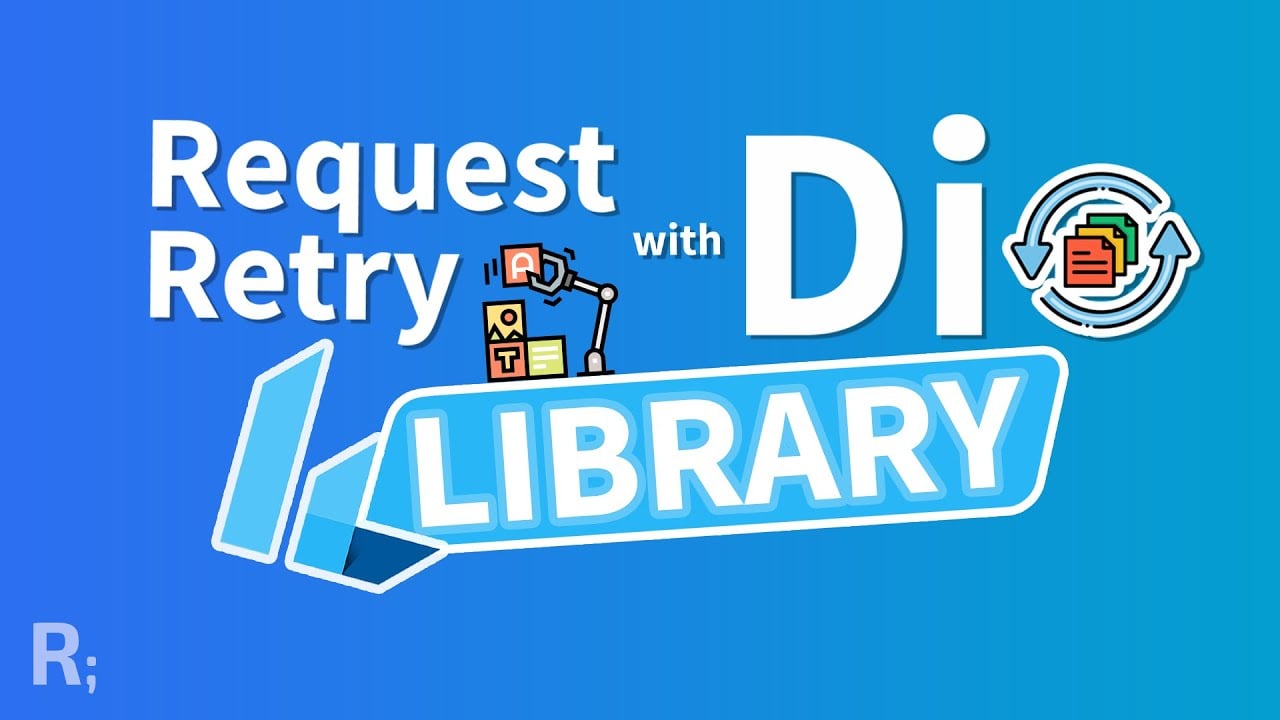Performing HTTP requests is all fun and games until there’s no internet connection. Sure, you can display a sad error message or a “Chrome dinosaur” to the user, but wouldn’t it be better to take the initiative and automatically retry the request when the user connects to a WiFi network or enables mobile data? This is precisely what we’re going to implement in this tutorial.
Starter project
We’re going to use the dio HTTP client and the connectivity package to accomplish our goal. We’re _not _using the default http package because it’s pretty lame. I mean, come on! No support for interceptors?
All of the packages and the basic UI is prepared for you in the starter project so that you won’t waste time if you want to follow along.
Creating an interceptor
Interceptors run every time you do some action on a Dio object. You can then perform logic in three callback methods - onRequest, onResponse and onError.
They are useful for plenty of things such as logging or, in our case, scheduling a request retry when we detect there’s no connection. You are probably familiar with the dreaded SocketException that gets thrown when the device isn’t connected to a network. This means only one thing - we’re going to utilize the onError callback.
retry_interceptor.dart
class RetryOnConnectionChangeInterceptor extends Interceptor {
@override
Future onError(DioError err) async {
// TODO: Schedule a retry
}
}
This is the basic outline of our interceptor. We’re going to get to the retry logic in just a bit but first, it’s important to note that the onError callback will run for all kinds of errors including status codes such as 401 or 503. I think it’s a good idea to retry the request only when the error is the aforementioned SocketException.
How can we find out which exact type of of an error occurred? We can use the handy fields of the DioError object!
retry_interceptor.dart
@override
Future onError(DioError err) async {
if (_shouldRetry(err)) {
// TODO: Schedule a retry
}
// Let the error "pass through" if it's not the error we're looking for
return err;
}
bool _shouldRetry(DioError err) {
return err.type == DioErrorType.DEFAULT &&
err.error != null &&
err.error is SocketException;
}
Request retrier
Having the interceptor is only one part of the game. How can we actually schedule the failed requests to be retried as soon as the device is connected to a network? The answer is connectivity package, Stream and a Completer.
We could just plop this logic right into the RetryOnConnectionChangeInterceptor but I’m a proponent of keeping the code focused on one task. Let’s create a DioConnectivityRequestRetrier.
dio_connectivity_request_retrier.dart
class DioConnectivityRequestRetrier {
final Dio dio;
final Connectivity connectivity;
DioConnectivityRequestRetrier({
@required this.dio,
@required this.connectivity,
});
Future<Response> scheduleRequestRetry(RequestOptions requestOptions) async {
// TODO: Implement
}
}
scheduleRequestRetry will be passed the failed RequestOptions object which will be used to perform the same request for the second time. We’re then going to return the successful Response back to the interceptor which scheduled a request retry.
To retry the request immediately when the network connection changes, the Connectivity class offers a handy Stream called onConnectivityChanged.
dio_connectivity_request_retrier.dart
Future<Response> scheduleRequestRetry(RequestOptions requestOptions) async {
StreamSubscription streamSubscription;
streamSubscription = connectivity.onConnectivityChanged.listen(
(connectivityResult) async {
// We're connected either to WiFi or mobile data
if (connectivityResult != ConnectivityResult.none) {
// Ensure that only one retry happens per connectivity change by cancelling the listener
streamSubscription.cancel();
// Copy & paste the failed request's data into the new request
dio.request(
requestOptions.path,
cancelToken: requestOptions.cancelToken,
data: requestOptions.data,
onReceiveProgress: requestOptions.onReceiveProgress,
onSendProgress: requestOptions.onSendProgress,
queryParameters: requestOptions.queryParameters,
options: requestOptions,
);
}
},
);
}
The connectivity package does not guarantee that the user is actually connected to the world-wide web. The user may just happen to use a WiFi network without any Internet access. That’s not a problem though as in that case, the retry will again fail with a SocketException which you can catch as usual.
You may have noticed something fishy going on in the code above. There’s no return **statement! **It’s not as simple as returning the result of calling dio.request() directly. After all, the request happens inside a closure of the listen method and we want to return the Response from the scheduleRequestRetry method.
This is just the right occasion to use a Completer. We can return its Future from the whole scheduleRequestRetry, which we will then complete from the closure.
dio_connectivity_request_retrier.dart
Future<Response> scheduleRequestRetry(RequestOptions requestOptions) async {
StreamSubscription streamSubscription;
final responseCompleter = Completer<Response>();
streamSubscription = connectivity.onConnectivityChanged.listen(
(connectivityResult) async {
if (connectivityResult != ConnectivityResult.none) {
streamSubscription.cancel();
// Complete the completer instead of returning
responseCompleter.complete(
dio.request(
requestOptions.path,
cancelToken: requestOptions.cancelToken,
data: requestOptions.data,
onReceiveProgress: requestOptions.onReceiveProgress,
onSendProgress: requestOptions.onSendProgress,
queryParameters: requestOptions.queryParameters,
options: requestOptions,
),
);
}
},
);
return responseCompleter.future;
}
Putting it all together
With this retrier class in place, we can now plug it into the interceptor.
retry_interceptor.dart
class RetryOnConnectionChangeInterceptor extends Interceptor {
final DioConnectivityRequestRetrier requestRetrier;
RetryOnConnectionChangeInterceptor({
@required this.requestRetrier,
});
@override
Future onError(DioError err) async {
if (_shouldRetry(err)) {
try {
return requestRetrier.scheduleRequestRetry(err.request);
} catch (e) {
// Let any new error from the retrier pass through
return e;
}
}
// Let the error pass through if it's not the error we're looking for
return err;
}
bool _shouldRetry(DioError err) {
return err.type == DioErrorType.DEFAULT &&
err.error != null &&
err.error is SocketException;
}
}
The main.dart file from the starter project contains a working code to perform GET requests with Dio. All we need to do, is to plug the interceptor into it.
main.dart
class _HomePageState extends State<HomePage> {
Dio dio;
String firstPostTitle;
bool isLoading;
@override
void initState() {
super.initState();
dio = Dio();
firstPostTitle = 'Press the button 👇';
isLoading = false;
dio.interceptors.add(
RetryOnConnectionChangeInterceptor(
requestRetrier: DioConnectivityRequestRetrier(
dio: dio,
connectivity: Connectivity(),
),
),
);
}
...
}
And just like that, you now know how to retry requests automatically when device connection state changes. It’s going to create a much better user experience than just passively saying “no connection, retry by pressing a button”.
#flutter #mobileapps #webdev
